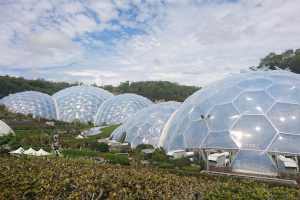Regenerative Architecture and its Relationship to Product Manufacturers
- < The Hierarchy of Manufacturer Building Product Reps
- > 4 Steps to Getting Your Building Products Specified
Regenerative and sustainable. I thought they were the same thing and interchangeable. But was caught in the internet spiral of clicking from one article to the next the other day and I discovered that, while they are similar concepts, they differ in one pivotal way. Linguistically, both terms have meanings that differ a bit from how they’re actually used. Sustainable means self-sustaining, but for the AEC community, it is used to mean products and buildings that are less toxic or harmful to the environment. Similarly, the linguistic definition of regenerative means “to bring into existence again”, but the AEC community uses it to describe design and products that give back to the environment, that not only helps to sustain an environment but also helps to give back to the environment. The way I best understood this was if our goal is sustainable architecture and design, then we are working to maintain a finite supply of resources. But with regenerative architecture and design, we are hoping to build in such a way that we are contributing to the improvement of the environment or ecosystem.
In a previous blog, Creating Space to Nurture Our Human Nature in the Built World, I discussed biophilic design which focuses on the connection between humans and the natural world. Regenerative architecture takes that even further, focusing on reducing the environmental impacts of buildings. But it also treats the environment as an equal partner in the architecture, creating a symbiotic relationship between the building and the ecosystem it inhabits. I like to think it in super simple terms: “Leave the place better than you found it.” While the idea of sustainability worked when it was first introduced, it assumes what you’re working with is not in a state of damage control. But our environment has gotten to a point where it needs to be improved upon, not just sustained. Sustainability is like a linear path, taking care of what we already have and doing as little harm as possible. Regenerative design and architecture is a circular path, giving back equally or even more, to the planet.
How Building Can be Regenerative
A regenerative system makes zero waste. What it puts out is equal to or greater than its input. Regenerative design uses biomimicry as an example, modeling itself after nature where organic and synthetic materials are metabolized (used) and then metamorphosed (changed) into something else that is important in the closed regenerative system. In an article by HMC Architects, found in the June 2018 Building Design + Construction Magazine, regenerative architecture is seen as including net-positive strategies; for example, “elementary schools that…produce excess energy to power the surrounding neighborhood. We’re imagining hospitals with a stormwater management system to provide non-potable irrigation water back to its community. We’re dreaming up eco-cities with an entirely edible landscape that feeds its residents.” They encourage the AEC community to definitely check off the LEED box, but also to think bigger than that, further into the future.
So Where Does This Leave Product Manufacturers?
Transparency documents were discussed in a previous blog, 4 Transparency Documents That Help Specification on Both LEED v4 & WELL Projects. Health Product Declarations, Environmental Product Declarations, Life Cycle Assessments, and Declare Labels are all important not only for LEED certification, but to transition into getting specified on regenerative architecture projects (assuming that’s not already being done!) With regenerative architecture, though, the Life Cycle Assessment is pivotal.
3 Ways to Diagnose Your Dying AIA Continuing Education Course offers its Cradle to Cradle Certified Product Standard. This gives designers and manufacturers criteria and requirements for continually improving what products are made of and how they are made. Cradle to Cradle has five levels of certification, and three of them particularly serve the regenerative architecture and design industry well:
- Material Health:Knowing the chemical ingredients of every material in a product and optimizing towards safer materials.
- Material Reutilization: Designing products made with materials that come from and can safely return to nature or industry.
- Renewable Energy & Carbon Management: Envisioning a future in which all manufacturing is powered by 100% clean renewable energy.
As a manufacturer, if you start focusing on the regenerative properties of your product, and take care of your transparency documents, then you’ll find yourself in position to be considered for specification. Maybe your product won’t ever be regenerative on its own, but can it contribute to a regenerative cycle? The green build and design industry is looking more and more at regenerative design. Are there ways you’ve already jumped in? Has the move toward regenerative design affected your specification opportunities in any way?
For more information or to discuss the topic of this blog, please contact Brad Blank





